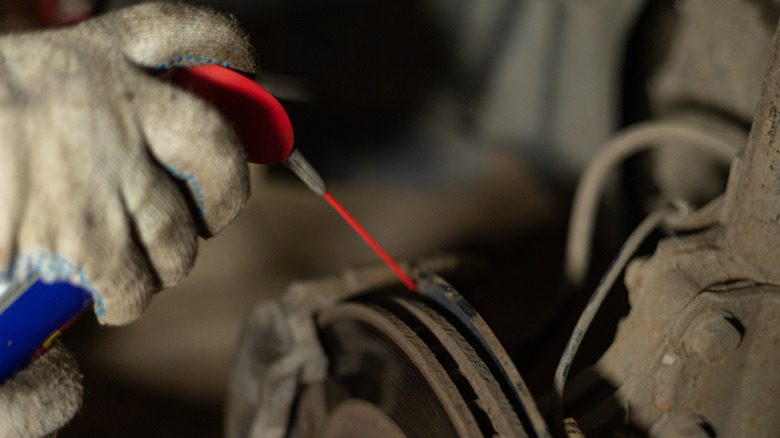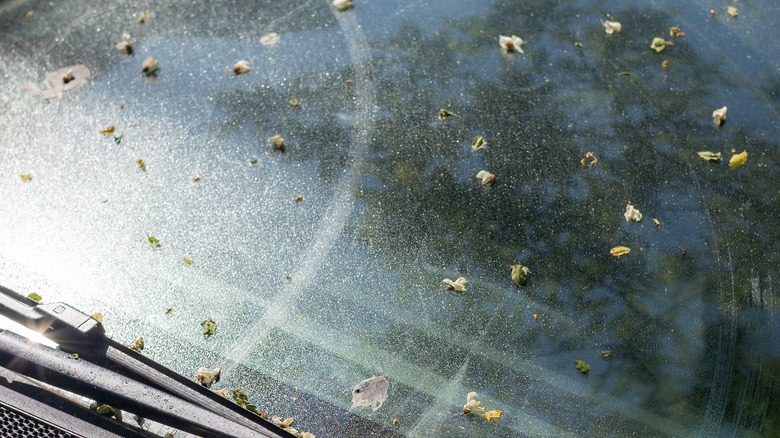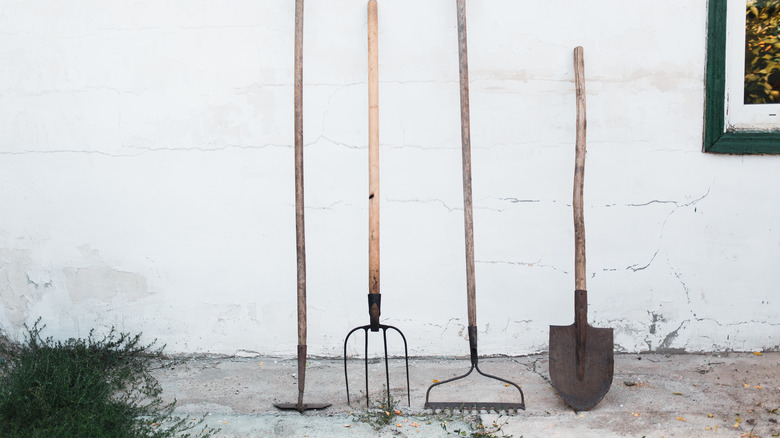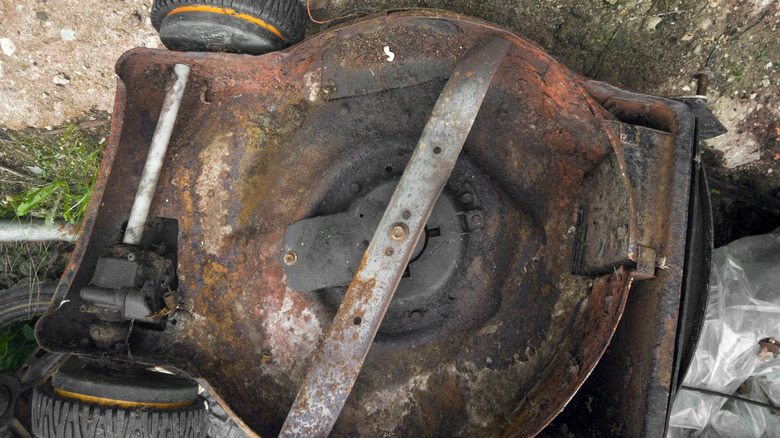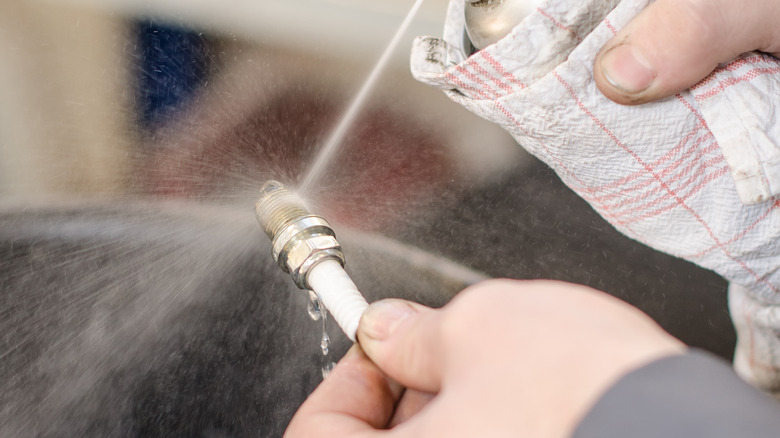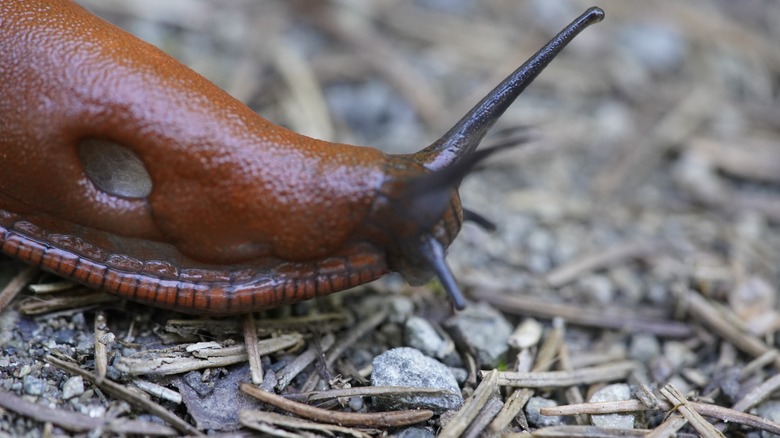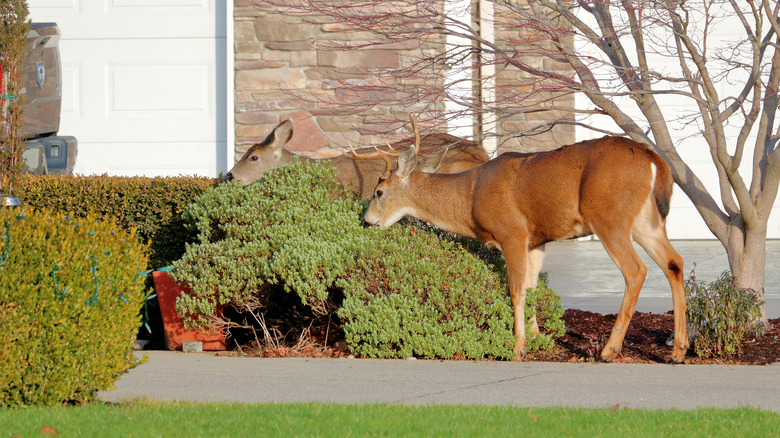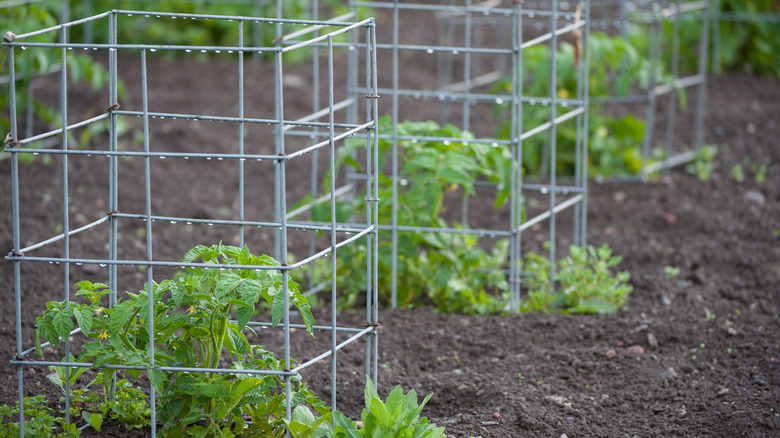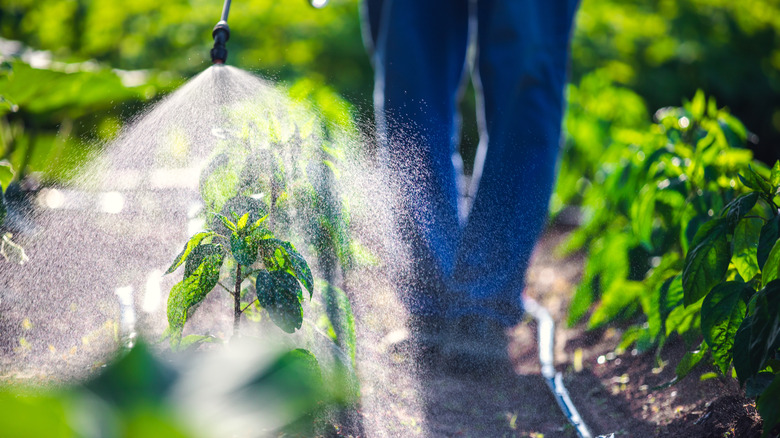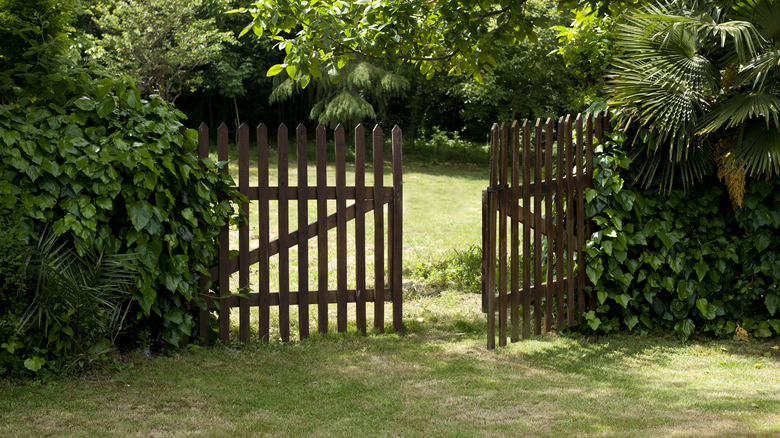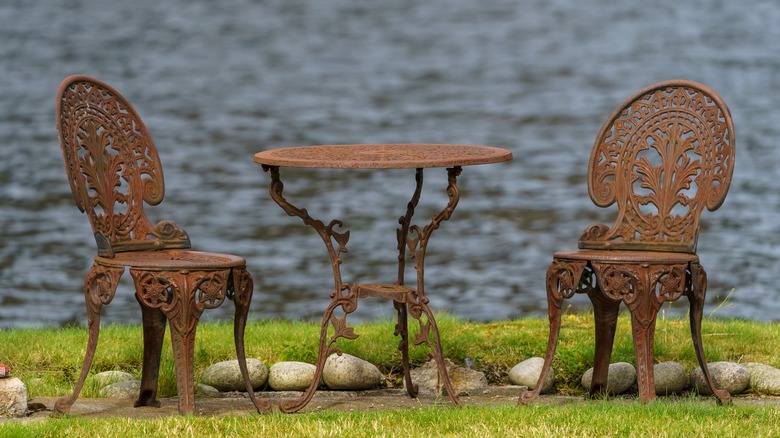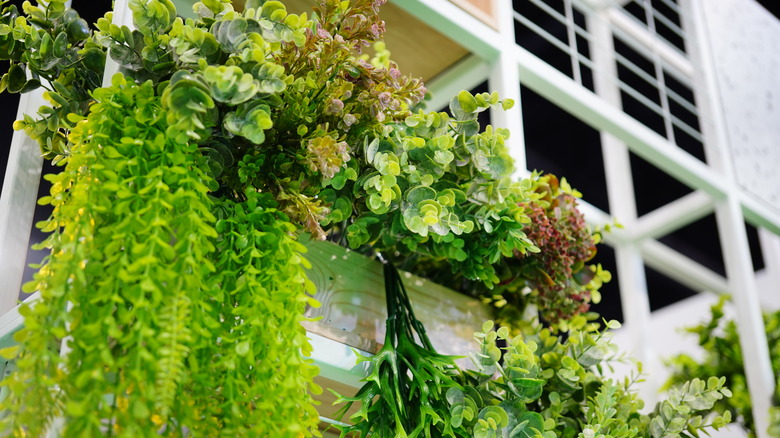Clever Ways To Use WD-40 For Your Lawn And Garden
Oh, WD-40. Many consider it the solution to any problem. Whether for maintaining fishing gear or getting the squeak out of an old fence, WD-40 is there for us when we need it most. Still, we have a few questions. We know that WD-40 makes an excellent companion in the garage or at the marina, but what can it do for our lawn and garden? Quite a lot, as it turns out.
Nearly everyone knows that the "WD" in WD-40 stands for "water displacement." The purpose of the substance, according to the WD-40 website, is to literally displace moisture out of where it isn't supposed to be. While the company maintains its secret recipe of solvents and lubricants, WD-40 has more than proven itself to reduce or eliminate corrosion, and keep water out of hard to reach places.
Hold on! Isn't water supposed to get into my lawn and garden? Yes, of course. These clever WD-40 tips are not meant to substitute for natural lawn and garden maintenance. On the contrary, because it's toxic when ingested, you shouldn't be spraying WD-40 on your grass or produce at all. Still, there are plenty of ways to use the stuff to care for your lawn and garden. Here are 11 clever ways to use it.
Remove tree sap
When the spring thaw hits, the sap starts flowing. Many of us have experienced its sticky viscosity, whether on the windshields of our cars or the blades of our pruning saws. Sap is going to do quick work of making everything mucked up and sticky. Sugars and water move through the tree to create sap during photosynthesis. Depending on how much sugar is present, some sap, like pine, will be stickier than others.
WD-40 can help by loosening and cleaning away stuck-on tree sap. It's particularly useful on chainsaws. Sap and sawdust will muck up the blades of a chainsaw faster than you can imagine. However, some soaking in WD-40 and a wipe down with a rag are all you need to get the stuff out and prevent it from sticking in the future.
You could also use WD-40 to remove sap from plants. This is only recommended for ornamental varieties — the plants which you won't be eating. Don't spray directly onto the plant. Instead, lightly wet a rag with WD-40 and gently wipe away the tree sap. You may have to do this several times depending on how thick the stuck-on sap is.
Clean garden tools
The most wonderful thing about WD-40 is its various applications on tools. With the same substance, you can prevent ice from sticking to your snow shovel, clean it, and prevent rust all in one spray. The same is true for garden tools. No matter how careful you are, your garden tools are going to get messy. Having some WD-40 on hand in the tool shed is great for keeping them clean.
WD-40 is going to do a lot more than just clean your tools. Yes, it will loosen up the dirt and caked-on grime, but it will also create a protective coating on the metal. Because WD-40 displaces water, moisture is not going to be able to seep into the metal and create rust. Instead, it will bounce away. So, if you accidentally leave your tools out during a storm or forget about them for a few days, don't worry. The WD-40 will protect the metal parts of your tools.
Spray the WD-40 directly onto the dirty tools. Wait a few minutes for it to soak in and loosen whatever gunk is on the blades. Wipe with a rag and repeat until all the dirt is gone and the metal has a nice sheen on it. Use steel wool or a metal brush to take care of anything that is particularly stubborn.
Prevent corrosion on lawnmower blades
One thing we're all guilty of when it comes to lawncare is not giving our equipment the maintenance it needs. Nowhere is this more true than lawnmowers. Sure, on the outside, the machine can look pristine and excellent, but the underside could be riddled with corrosion we're not seeing because of the fact that we're not cleaning it regularly.
While it can be difficult to get the underside of your lawnmower totally clean, it is necessary to do so because the build-up of yard clippings has the potential to jam your blades and create corrosion from excess moisture. So, between every cut, clean the underside of the lawnmower. Scrape away any excess buildup of lawn trimmings and give the underside a good wipe-down with a dry rag. Then, spray WD-40 all around the interior. Wait for a few minutes to allow it to sink in before buffing it out with a rag.
As with the garden tools, this will help create that protective coating across the bottom of the lawnmower. It does a world of good for your blades, as it both prevents rust and keeps grass clippings from sticking. It also goes a long way toward keeping them sharp and free of corrosion.
Clean engine parts
It doesn't matter what kind of small engine you have, it is going to need preventative maintenance. This is especially true with lawncare and gardening equipment like lawnmowers, tractors, and trimmers. Fact is, if they run on gasoline, which most do, the engine parts are going to require sufficient lubrication. Most lubrication comes in the form of engine oil, but if things get clogged up, WD-40 is one of the best ways to clean your parts and keep them free of corrosion.
Use WD-40 to clean out carburetors and loosen spark plugs. Spark plugs benefit enormously from WD-40. Not only will it make it easier to remove the plugs, but you can clean away any erosion on the threads. By doing so, you also keep moisture away from the spark plugs, which is good because they provide the spark to ignite the engine. If they're too wet or badly corroded, you're going to have trouble starting your engine.
If this happens, what you can do is remove your spark plugs, and clean them with a rag and WD-40. Allow the solvent to sink into the metal before returning the spark plug to the engine. With any luck, your machine should fire right up.
Prevent slugs and snails
Everyone wants to protect their lawn and garden from invaders. More often than not, the trespassers come in the form of various insects. While most of these bugs are enormously beneficial to your garden, others, like slugs and snails, are not. If left to their own devices, snails and slugs will devour everything you could possibly grow. However, there is a simple solution to this. It involves our old friend, WD-40, and some plant containers.
Anyone who doesn't have the space to sow a garden directly into the ground would do well to utilize containers. They come in a variety of different sizes, and you can grow an abundance of food with them. They are also great at warding off slugs. Normally, a slug would be able to climb a potted plant thanks to the sticky residue produced by its underbelly that allows it to climb vertical surfaces. Not so with an application of WD-40.
Spray and wipe some WD-40 on the outside of the pots, and the surface becomes so slippery that no amount of slug or snail will be able to get up to your plant and nibble upon it. You'll need to reapply the WD-40 every once and awhile, but the slipperiness, along with the smell, should be enough to keep the slugs away for good.
Keep animal pests out
There are many strong scents that work wonders at keeping pests away from your lawn and garden. Garlic is excellently astringent, while cinnamon is hot and spicy. However, if you're looking for something with more pep, you might want to consider WD-40. While some people love the slightly sweet smell of WD-40, there are an equal number of folks who don't. Regardless of what camp you find yourself in, one thing's for sure. WD-40 repels animal pests extremely well.
That love/hate scent works to repel a number of different animal pests from invading your garden shed, greenhouse, garage, or gated garden. These include rodents like rats and mice, wild rabbits, deer, and pestilential birds like pigeons, blue jays, and grackles. It is enough to spray and wipe the border of wherever you want to keep the pests out of with some WD-40.
The smell will wear off after a while, so reapply as needed. However, just because we cannot smell it does not mean that the animals can't. Thanks to their highly attuned senses, animals will smell the lingering scent of WD-40 long after we can no longer pick it up. So there's a plus.
Prevent plant supports from rusting
A garden tool category we don't often consider is the support systems we use for heavier, vining plants like tomatoes. These are a series of metal or wooden structures, like cages or posts, that help keep the plant upright when the heavier fruit begins to force it downwards. As these structures provide excellent support for the plants, it would be a shame if they lost some of their integrity due to lack of maintenance.
This is where WD-40 can help. If your support structures are made out of wood, the solvent won't really help. However, if they are made out of metal, the WD-40 will wick away any moisture that threatens corrosion or rust. You see, when metal rusts, it weakens. As a result, when your tomatoes put any real weight on them, the cages can collapse and be of no further use to you.
Apply the WD-40 in the same method as you would with your garden tools. Spray the cage down and allow the solvent to cure into the metal, then wipe away any excess. It is very important that you allow the WD-40 its curing time. If the solvent is too wet or there is any excess residue, it will leach into the plants, making them inedible.
Should you use it to keep weeds at bay?
We preface this with a question mark because we would consider using WD-40 as a last resort for anyone suffering problems with garden weeds. As mentioned earlier, you do not want to be spraying WD-40 on any of your garden plants. Firstly, it is not a material that can be ingested safely by people. Secondly, because it is a water displacer, it prevents the plant from getting water and thereby destroys its capability to feed itself.
Ironically, it is for this very reason that some have taken to using WD-40 to battle weeds. Keep in mind that other chemical herbicides and pesticides you spray onto plants are just as damaging to your body as those found in WD-40. The only difference is that you know what's in the pesticides. Anyway, spraying WD-40 on prickly weeds like thistles prevents the plant from receiving any water. As a result, the plant will dry out and die.
Whenever you are using WD-40 on weeds, try and make sure that you are only spraying the leaves of the weeds and not the surrounding ground. The solvent can very easily leach into the earth and create toxicity for the other plants around it. Immediately remove any weeds that you've killed with WD-40 as soon as they've died.
Keep your hinges from squeaking
Fixing something that squeaks is perhaps the most commonly recommended use for WD-40. Someone will say: "Spray some WD-40 on it and call it a day. Nothing more to it!" There are a number of different things that could gunk up the works of a hinge. The original lubricant could be dried up. There could be rust. The metal could be worn and scraped against itself. Whatever the reason, WD-40 can make it stop.
Thanks to the secret lubricants that make WD-40, a good soaking of the hinge should solve whatever squeaking issues you might have. Garden gates are notoriously squeaky. Unless you're one of those people who identify their guests by the noise of the gate, we'd recommend using some WD-40 to make the sound go away.
You could do this one of two ways. First, you could spray the stuff directly onto the hinges, allow things to soak, clean away the rust, and then wiggle them back and forth until the solvent has reached all the moving parts. Or, you could remove the hinge entirely, lay it down in a container, and soak it in WD-40. Though a little more labor intensive, this method provides you with the best possible coverage of the hinge. Once you replace it, there should be no more squeaking.
Clean and repair garden furniture
It doesn't matter if your lawn furniture is made of plastic or metal; WD-40 can polish and clean it in the same manner. On plastic furniture, WD-40 will apply a water-resistant coating, which will also create a polishing sheen on the material. So, if you're looking to spruce up those plastic Adirondack chairs you placed next to your value-improving fire pit, spray them down with WD-40, and buff them out with a rag. See how they shine after that.
If you've got metal lawn furniture, WD-40 is really going to be your friend. You can prevent everything from minor surface rust to major corrosion from happening. By cleaning it with WD-40, you apply a protective coating that is really going to polish up the metal.
Though it is not overly common, you can use WD-40 on finished or unfinished wooden surfaces. The oils in the wood will help bring out the shine and color of the wood. You can also add a WD-40 layer over whatever treatment has already been used on the wood to add extra water-repellent capabilities.
Clean your fake plants
Let's face it, not everyone is blessed with a green thumb. While you might remember the gaudy fake plants your older relatives used in place of real ones, the fake plants you can purchase today look so real that there are many who could easily be fooled into thinking that they are so. However, once they've spent sufficient time out in the sun and other weather, they could very easily begin to show their true colors and lose some of their luster. The solution? You guessed it, WD-40.
The same principle that applies to items throughout this list applies to your fake plants as well. Since WD-40 is able to make your plastic lawn furniture shine like new, as well as provide it with a protective coating, so too will it work on your fake plants. Polish them with a rag soaked in WD-40 and see the cleaning and shining power you get as a result. And that is all the work you will have to do on them. Pretty easy, huh?
You could easily get creative with what you use WD-40 for. There is no shortage of lists telling you exactly what you could do with it. However, these clever ways to use it are going to make your life outdoors all the easier in seasons to come.
